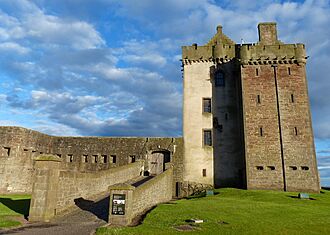Broughty Castle facts for kids
| Broughty Castle | |
|---|---|
Quick facts for kids 
Broughty Castle in 2017
|
|
| General information | |
| Location | Broughty Ferry, Dundee, Scotland |
| Technical details | |
| Material | Stone |
| Official name: Broughty Castle | |
| Designated: | 30 November 1981 |
| Reference #: | SM90043 |
| Siege of Broughty Castle | |||||||
|---|---|---|---|---|---|---|---|
| Part of Anglo-Scottish Wars Rough Wooing |
|||||||
 Broughty Castle |
|||||||
|
|||||||
| Belligerents | |||||||
| Commanders and leaders | |||||||
| Earl of Arran Earl of Argyll James Doig of Dunrobin Paul de Thermes Henri Cleutin |
Sir Andrew Dudley Sir John Luttrell |
||||||
| Strength | |||||||
| Unknown | 300 (at final assault) 5 warships |
||||||
| Casualties and losses | |||||||
| 50 (final assault) | Unknown | ||||||
Broughty Castle is a historic castle located on the shore of the River Tay in Broughty Ferry, near Dundee, Scotland. The main part of the castle was finished around 1495. However, a fort was first built on the site in 1454.
The castle's central tower has four floors and was built by Andrew, 2nd Lord Gray. Today, the castle is protected as a scheduled monument, which means it is a nationally important historical site.
Contents
History of the Castle
The 'Rough Wooing' War
In the 1500s, the castle was involved in a war between Scotland and England called the War of the Rough Wooing. This war happened because England's king wanted the young Mary, Queen of Scots, to marry his son.
After a major battle in 1547, the castle's owner, Lord Gray of Foulis, sold it to the English. The English knew the castle was important. An English writer, William Patten, said that controlling the castle meant controlling the River Tay. This would give them power over nearby towns like Dundee and Perth.
The English army, led by Sir Andrew Dudley, quickly made the castle stronger by digging a large ditch. They also had soldiers from Italy and Spain. The nearby town of Dundee agreed to support the English soldiers, but only because English warships were threatening them.
The Scots tried to take the castle back several times but failed. In January 1548, the English brought in more weapons, including 100 guns called matchlocks. They also planned to build new fortifications on a nearby hill to make the castle even safer.
A new English commander, Sir John Luttrell, took over. He had to deal with many problems, including poorly built new walls that he worried would fall down on their own.
The Castle is Recaptured
By Christmas 1549, Mary of Guise, the mother of the Scottish queen, held a meeting. She and her advisors decided to bring in more powerful French cannons to attack the castle.
The final attack began in February 1550. French and Scottish soldiers, led by the French commander Paul de Thermes, surrounded the castle. Mary of Guise watched the battle from across the river. After six days of fighting, the English soldiers surrendered.
Sir John Luttrell was captured. He was later released after a ransom was paid.
Later Centuries
In 1651, during the Wars of the Three Kingdoms, the castle was attacked again. This time, the soldiers defending it fled without a fight. The Gray family sold the castle in 1666, and it slowly fell into ruin.
In the 1800s, things changed. A railway company bought the castle in 1846 to build a ferry harbor next to it. Later, in 1860, the government bought the castle. They were worried about an invasion from France, so they rebuilt and fortified it. They added new walls, wings, and places for nine large guns.
From 1886, the castle was used by submarine miners. These were special soldiers who would place underwater mines in the river to stop enemy ships during a war.
The Castle in Modern Times
The castle was used by the military until 1932, and again during World War II from 1939 to 1949. After the war, it was no longer needed for defense.
In 1969, Broughty Castle opened as a public museum. It is now run by Leisure & Culture Dundee and has exhibits about the area's history, including its whaling and fishing past.
Facing Closure
In February 2024, it was announced that the castle might close because of budget cuts by Dundee City Council. Many people were upset by this news. After a public outcry, the council provided funding to keep it open for a while.
However, in May 2024, the long-term future of the castle was still uncertain. A final decision was made on December 2, 2024, when the council voted to close the castle in October 2025. Despite the vote, local groups are working to find a way to keep the site open for the community.
Gallery






